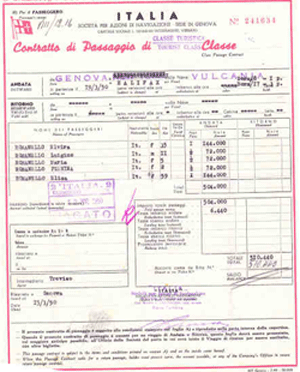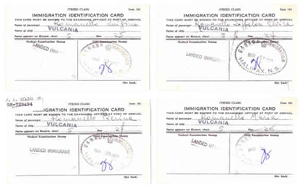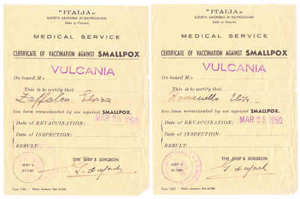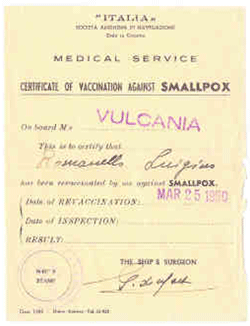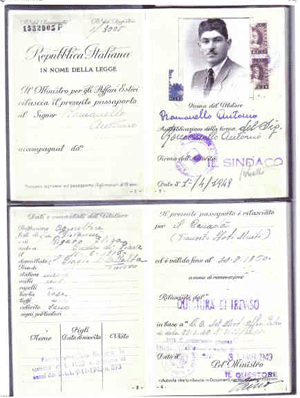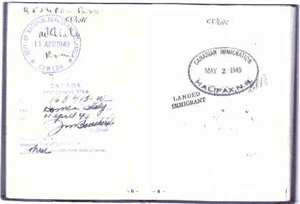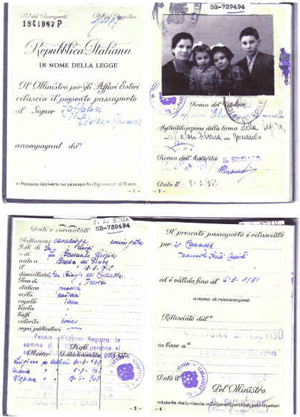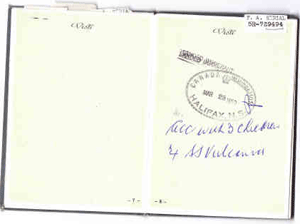Sobey Wall of Honour
Column
147
Row
3
An Account of the Immigration of the Romanello Family to Canada from Italy in 1949-50.
This is the story of Antonio Romanello, born on the 16th of June, 1915 of Giovanni Romanello and Elisa Rigato and of Elvira Romanello, nee Zaffalon, born on the 13th of May, 1915 of Luigi Zaffalon and Luigia Beninatto. Both were born in and lived in the village of Breda di Piave in the province of Treviso, Italy. It is also an account of their children, Luigino, born the 30th of March 1938, Maria, born the 5th of August 1945 and Pierina, born the 12th of June 1948.
As was the case with almost all of the countries of continental Europe during and after the Second World War, hardship and poverty were the norm. Our father, Antonio, after serving with the Alpini Regiment of the Italian army, returned to Breda di Piave to take up his chosen profession of cheesemaker. Although the profession was a prestigious one, requiring a specific set of skills and knowledge, it was also a demanding one. It required being at work at very early hours in the morning to receive the milk from the local farmers who supplied the factory, and then endless hours throughout the day and evening to supervise the stages in the cheesemaking process. Our father was looking for something better and it seemed that Canada, with its promise of better jobs and opportunities seemed to be that better place.
Many years prior, our Zio Virginio Rigato, brother of Eliza Rigato, had established a good life in Port Arthur, Ontario Canada. He began with the purchase of a gravel truck and eventually grew his business to a large sand and gravel supply company. When Dad expressed an interest in coming to Port Arthur, Virginio encouraged him to come and helped to arrange a sponsor (someone who would employ Dad for a year while he established himself). That sponsor was Pat Ross, a local farmer who lived at the crossroads of Oliver Road and Townline Road. This was all that Dad needed. On the 4th of April 1949, he was issued an Immigrant Visa in Rome by a Canadian Visa Officer named J.M. Bouchard. All Dad had to do was make it to a Canadian port of entry within 3 months. He didn't waste any time, because after boarding the MV Sobieski, a Polish liner, and enduring what must have been at least a ten day voyage, he along with his first cousin by marriage Tullio Cenedese, arrived at Pier 21 in Halifax, Nova Scotia. He was deemed a landed immigrant in Canada on May 2, 1949.
During that first year, Dad did help Pat Ross work the farm to fulfil his sponsorship requirements, but that was not all he did. He also set about preparing for the arrival of the rest of the family in April of the following year. First, through a friend of Uncle Virginio named Vic Delbianco, he secured a full time job as a labourer at the Canada Malting Company, one of the many grain elevator companies on the Port Arthur waterfront. Secondly, he purchased a small farm and home in the fall of 1949 at 1289 Oliver Road, the place where he would eventually raise his family and live out the rest of his life.
All of this effort helped pave the way for the arrival of the rest of the family, which began with the embarkation of the SS Vulcania from Genova, Italy on March 19, 1950, carrying Elvira, Luigino, Maria, Pierina and Elisa (grandmother) Romanello. Elvira and Elisa paid the full fare of 144,000 lire each and the three children were each charged half fare at 72,000 lire per person. With embarkation taxes of 6,440 lire, the whole ticket price for all was 510,440 lire which in today's dollars would have amounted to the princely sum of $363.04. This trip must have taken exactly 10 days because the Immigration Identification cards for everyone were stamped in Halifax indicating Landed Immigrant status on March 29, 1950.
The comfort level on a voyage across the North Atlantic in March must have left much to be desired, first because the word "cabin" on the passenger ticket was stroked out with a typewriter and replaced with "dorm" and secondly of course, because of the likelihood of rough weather in winter. Luigino confirmed that indeed, the accommodations were dormitories in which men and women were separated. Each dorm had a series of double bunks for sleeping. What we also know is that Elvira was confined to the dormitory for the entire trip because of seasickness. While Nonna Elisa became the caregiver for Maria and Pierina, Luigino, who was already 11 years old, became the courier and helper bringing food to the rest of the family. The ship's doctor was kept busy with the Romanellos. On March 25th 1950, all except the two girls were vaccinated against smallpox. Also, Luigino who remembers having a boil on his nose had to visit the doctor daily for treatment.
They arrived in Halifax on the morning of March 29th and as soon as they were released by the immigration officials, they immediately bought train tickets for the 2 day trip to Port Arthur. Luigino recalls being with his grandmother when the tickets were purchased. The agent had attempted to charge her for three adult fares and two children. Luigino remembers his nonna saying, "No, Luigino will not be age twelve until tomorrow." She was right! She had to pay only half fare for him.
Although the train trip was lengthy and generally unmemorable, both Elvira and Luigino had clear memories of the day they arrived in Port Arthur. Louis recalls jumping off the train at the Canadian Pacific Railway station before the train had even stopped moving to greet his father and scold him for not coming to Halifax to pick them up. Elvira may not have been quite so excited. Before leaving Italy she had been advised that it was the fashion for "Americani" women to wear hats, so of course Elvira bought one and wore it for her arrival. She always used to say later that as soon as she arrived in Port Arthur she traded in the hat for an apron and never wore it again. That was a bit of an exaggeration, but it made for a good story.
Life in those days was not easy for our family. To keep from freezing that coming winter everybody in the family helped cut and split wood from the area in back of the farm on what is now Central Avenue. Even Nonna Eliza helped. As it was in Italy, the Oliver Road house had no indoor plumbing; however, it was quite a different experience using an outhouse in the dead of winter here than it was back home. Water came from a well in the back of the house where it still is today. Then, there was a hand pump on it and water was brought into the house in buckets as it was needed. Elvira did all of her cooking on a wood stove then and in a much smaller area than we see there now. The kitchen and bathroom that we know now was added on many years later as well as a basement under the whole house. Also, in those early years, the Italian wine making tradition had to be adapted to new conditions. Then, there wasn't the money to go and buy grapes from a wholesaler like Buset's grocery. Instead, everyone picked Saskatoons. It did in a pinch, but Tony was very unsatisfied and soon wanted to save the money to buy grapes. We all loved his wine. It had a special taste that nobody has recreated since.
That was the beginning of our life in Canada. Each year after that we made progress and life got better.
